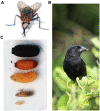The genome sequence of the avian vampire fly (Philornis downsi), an invasive nest parasite of Darwin's finches in Galápagos
- PMID: 34878103
- PMCID: PMC9210292
- DOI: 10.1093/g3journal/jkab414
The genome sequence of the avian vampire fly (Philornis downsi), an invasive nest parasite of Darwin's finches in Galápagos
Abstract
The invasive avian vampire fly (Philornis downsi, Diptera: Muscidae) is considered one of the greatest threats to the endemic avifauna of the Galápagos Islands. The fly larvae parasitize nearly every passerine species, including Darwin's finches. Most P. downsi research to date has focused on the effects of the fly on avian host fitness and mitigation methods. A lag in research related to the genetics of this invasion demonstrates, in part, the need to develop full-scale genomic resources with which to address further questions within this system. In this study, an adult female P. downsi was sequenced to generate a high-quality genome assembly. We examined various features of the genome (e.g., coding regions and noncoding transposable elements) and carried out comparative genomics analysis against other dipteran genomes. We identified lists of gene families that are significantly expanding or contracting in P. downsi that are related to insecticide resistance, detoxification, and counter defense against host immune responses. The P. downsi genome assembly provides an important resource for studying the molecular basis of successful invasion in the Galápagos and the dynamics of its population across multiple islands. The findings of significantly changing gene families associated with insecticide resistance and immune responses highlight the need for further investigations into the role of different gene families in aiding the fly's successful invasion. Furthermore, this genomic resource provides a necessary tool to better inform future research studies and mitigation strategies aimed at minimizing the fly's impact on Galápagos birds.
Keywords: Darwin’s finches; Galápagos; avian vampire fly genome; insecticide resistance; parasitic invasion.
© The Author(s) 2021. Published by Oxford University Press on behalf of Genetics Society of America.
Figures




References
-
- Adams MD, Celniker SE, Holt RA, Evans CA, Gocayne JD, et al.2000. The genome sequence of Drosophila melanogaster. Science. 287:2185–2195. - PubMed
-
- Addesso AM, Harvey JA, Vaziri GJ, Verrett TB, Albert L, et al.2020. Effect of introduced parasites on the survival and microbiota of nestling cactus finches (Geospiza scandens) in the Galápagos Islands. J Ornithol. 161:1011–1019.
-
- Bulgarella M, Quiroga MA, Boulton RA, Ramirez IE, Moon RD, et al.2017. Life cycle and host specificity of the parasitoid Conura annulifera (Hymenoptera: Chalcididae), a potential biological control agent of Philornis downsi (Diptera: Muscidae) in the Galápagos Islands. Ann Entomol Soc Am. 110:317–328.
Publication types
MeSH terms
LinkOut - more resources
Full Text Sources
